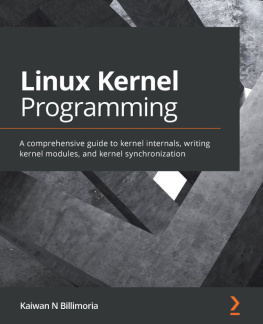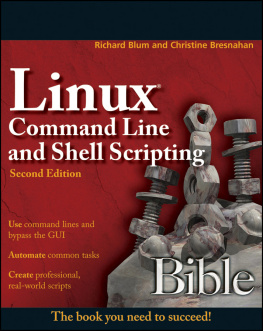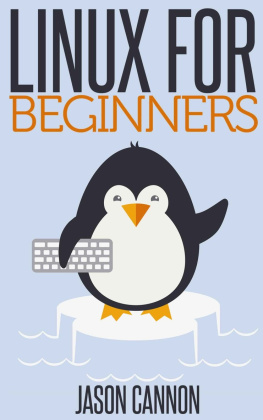LINUX Command-Line for Beginners
A Complete Step-by-Step Opening Guide to Study Linux from Scratch to Scripting and SSH commands, Linux terminals, editors, and shell.
Sam Chris
Table of Contents
Introduction
Chapter 1: What is Linux and Why Using It?
What is Linux OS?
Why Using Linux?
A host of different distributions
Linux is the same as freedom
Linux is excellent in reliability
Linux saves you money
You can easily try Linux
Linux can run on outdated systems
More sophisticated than before
Chapter 2: Linux Distributions and Types of Installations
Linux distribution for multi-purpose
Advanced users best Linux distributions
Older computers best Linux distributions
Best distributions of Linux server
Beginners best Linux distributions Server
Roles and Types of Installations
Chapter 3: Introduction to Linux Kernel and Operating System
The System Preparation
Chapter 4: Installing Linux on Virtual Machine
VMware Workstation Player Installation
The Importance of Virtual Machine
Chapter 5: Linux User Management and System Administration
How to Manage Users and Groups as a
Linux Administrator Linux Group
The File System of Linux
Chapter 6: Linux Directory Structures
Basic functions of the filesystem
Directory Structure of Linux
Chapter 7: Working with Disk, Media, and Data Files (gzip tar)
Analyze Disk Space and Hard Disk Partition on Linux with
These Commands
Linux Data Manipulation
Creating from the Command-line a File for Tar GZip
Chapter 8: File, Directory Manager, Permissions, Networking, and
SSH
SSH Command
Chapter 9: Linux Terminals, Editors, and Shell
Chapter 10: Basic Linux Shell Commands
Shell Commands
Other languages
Chapter 11: Shell Scripting
Features of Shell Scripting
Chapter 12: Building Script
Errors
Chapter 13: Basic Bash Shell Commands
Chapter 14: Advanced Bash Shell Commands
Conclusion
Introduction
Congratulations on purchasing your copy of LINUX Command-Line for Beginners: A Comprehensive Step-By-Step Starting Guide to Learn Linux from Scratch to Bash Scripting and Shell Programming and thank you for doing so.
Linux is in for all intents and purposes all that we use today. In case you are a novice or you are simply beginning to learn everything about Linux working framework, you will before long understand that downloading this eBook is a brilliant way into having an unmistakable comprehension of the universe of Linux just as a few of its conveyances. As a rule, exploring through the Linux order line can be very precarious. In this book, you will see various methodologies that you can display to have a smooth activity with Linux. Additionally, certain Linux disseminations you can utilize as a novice as well as those that can work on the off chance that you endeavor to utilize it on your old framework. Eventually, this book makes a stride further to break down essential Linux shell orders just as shell prearranging.
To this end, a portion of the parts in this book will talk about Linux client the board and organization, where it inspects a portion of the obligations of Linux framework head, including dealing with registries, clients broadly, and documents, fundamental slam orders, root, or superuser the executives, thus significantly more. Likewise, this book will talk about Linux record works just as characterizing the three sorts of Linux document possession, authorizations, and SSH orders. You will find out about other SSH orders, Linux terminals, editors, and shells.
With an unmistakable impression of catalogs, document directors, and editors far removed, this book will examine how you can make a record for tar gzip from the order line, how you can mount and unmounts media, and Linux information control.
On the shelves, there are several books on Linux Command-line, and for making this book your choice, we will like to appreciate the gesture. From our end, we are striving to see that this book provides you with all the practical and necessary information you will need to succeed. Once again, thank you!
Chapter 1:
What is Linux and Why Using It?
Fortifying nearly everything from cell phones, workers, and PCs, Linux is a standard working framework that individuals usually use. Undoubtedly, everywhere, a few people use Linux in all fields and applications you can envision. Linux has been around since the 90s. From your TV adhere to the ice chest and everything, Linux runs everything. Furthermore, a large part of the web has support from Linux. Since the PC working framework has controlled a few developments, numerous logical forward leaps have Linux to thank. Even though for quite a long time, Linux has been providing secure, solid OS obligations, "Linux" has no experience with the overall population.
Be that as it may, the Linux working framework is all over, from big business workers to homework areas, home machines, supercomputers, vehicles, and cell phones. All over the place, you will discover Linux, and it is on your TV, Roku gadgets, fridges, and indoor regulators. For being one of the calm, generally secure, and dependable working frameworks accessible, Linux prides itself as a favored stage running inserted frameworks, workers, and work areas from one side of the planet to the other.
What is Linux OS?
In any case, what do you comprehend by an OS or working framework? In an actual PC, the administration of the equipment is the obligation of the PC code known as the working framework. Between the equipment and programming, the working framework exists as a layer. Additionally, in constructing an agent, speaking with a designs card or tending to a CPU isn't what a great many people need to know. Furthermore, what goes about as a broker is a working framework like Windows or Linux.
Thusly, Linux, similar to Mac OS, iOs, and Windows, is a working framework. Basically, the Linux working framework powers Android, which is the most famous stage on the planet. The product is conceivable not to work without the working framework since, as a working framework, Linux deals with the correspondence between the equipment and programming.
There are such countless various pieces that Linux working framework includes and they are:
- Applications not all the total exhibit of applications that the work area conditions give. All things considered, you can rapidly discover and introduce a few great many programming that is excellent through Linux, common of macOS and Windows. There are straightforwardness and centralization in the application establishment by most current Linux circulations. For instance, run-of-the-mill GNOME Software, there is Ubuntu Software Center by Ubuntu Linux that, from one unified stage, speeds up the revelation and establishment of applications among a huge number of them for clients.
- Desktop environment clients can interface with this piece. You can browse a few work area conditions like Xfce, KDE, Enlightenment, Pantheon, Mate, Cinnamon, GNOME, etc. There are inherent applications for every work area climate, including games, internet browsers, design devices, and document directors.
- Graphical server on your screen, you will get a real showcase with this subsystem. It is known as X or X-worker by many individuals.
- Daemons in the wake of signing into the work area or startup during boot, these are foundation administrations like planning, sound, printing, etc.
- Init system client space is bootstrapped by this subsystem, and the control of daemons is in its charge. Accordingly, systems, as the most questionable, is an init framework most generally utilized. When the bootloader, as Unified Bootloader or GRUB, handles the underlying booting, the init framework deals with the boot interaction.
Next page




